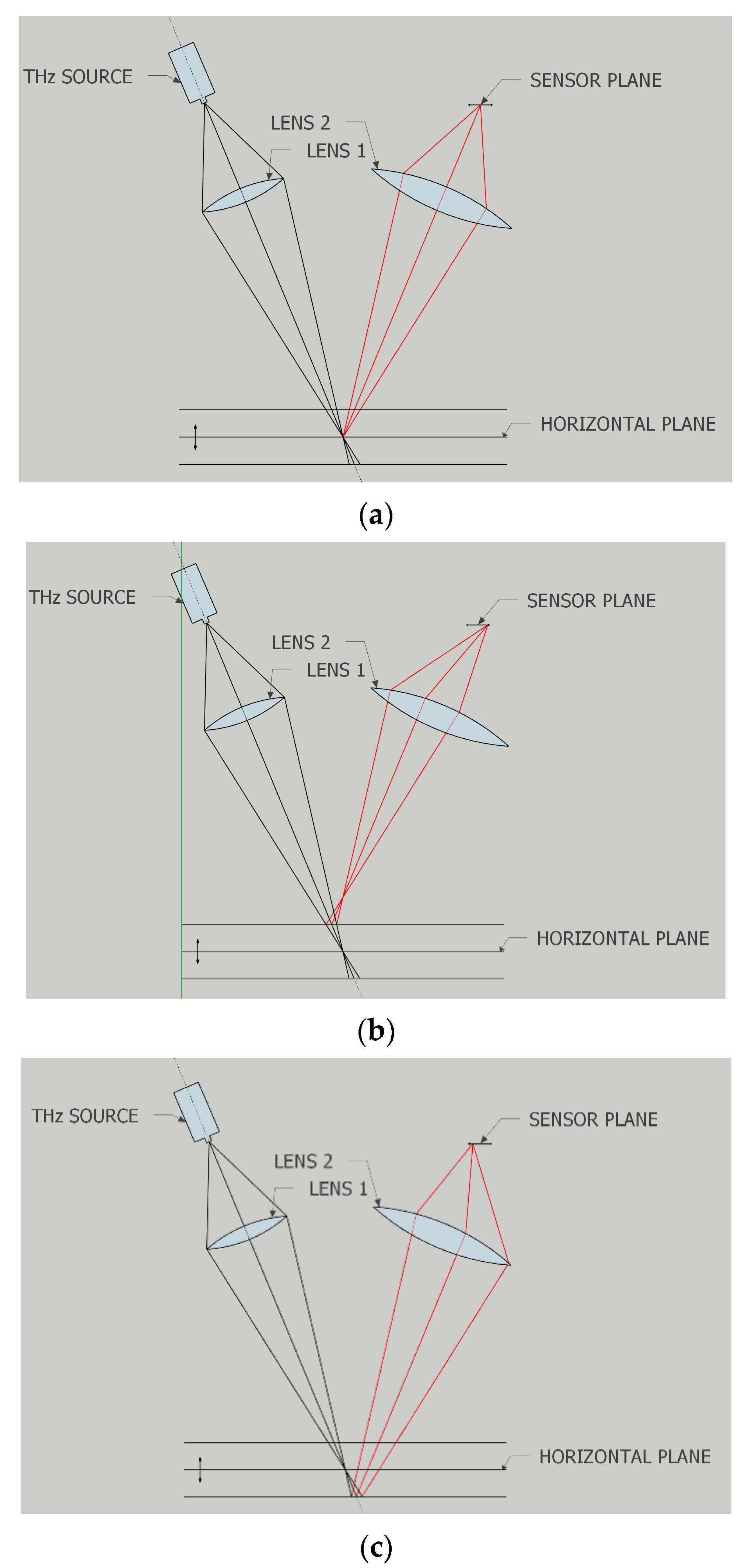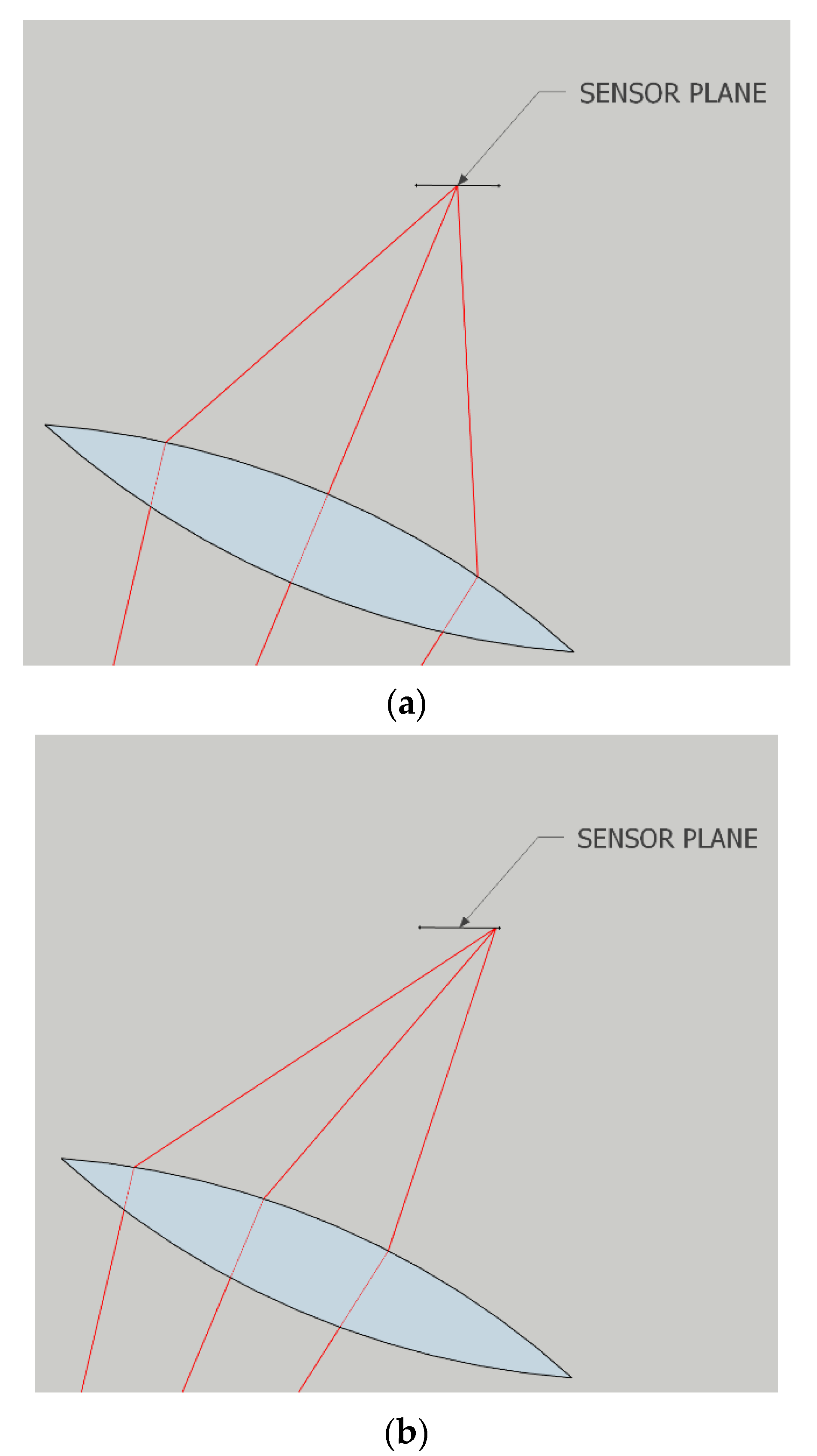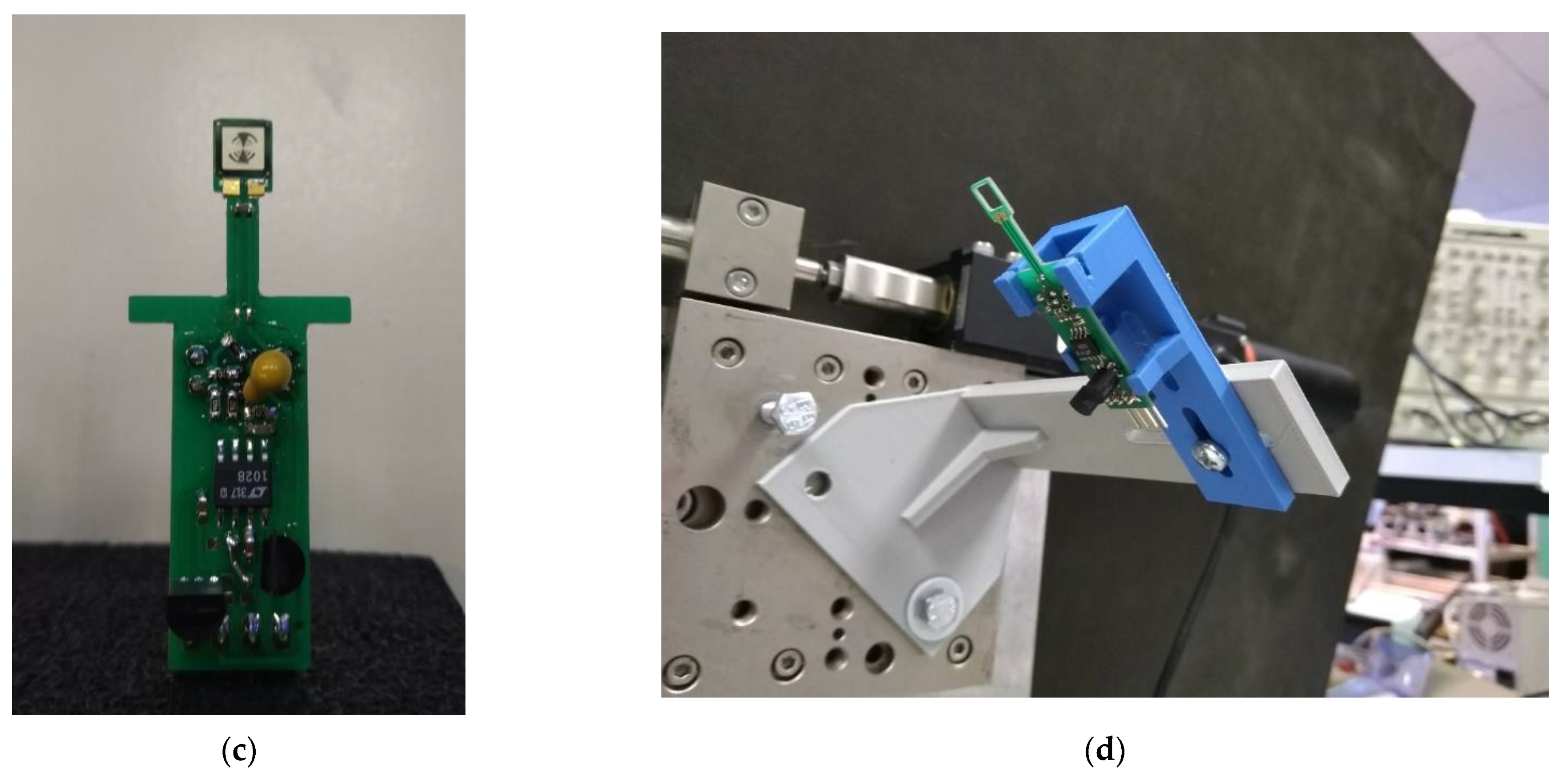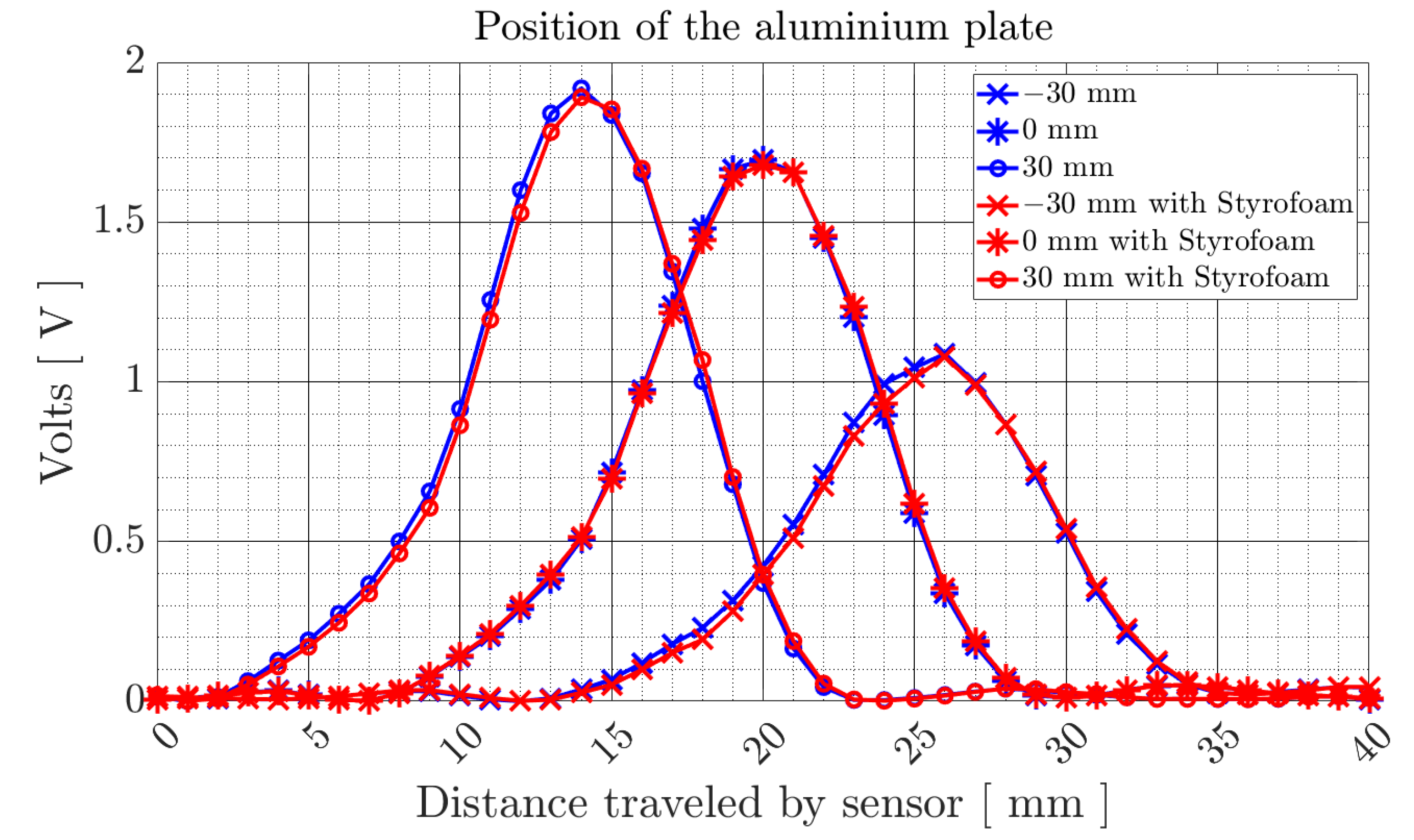Position Sensing with a Compact 0.1 THz Amplitude Modulated Source
Abstract
1. Introduction
2. Materials and Methods
2.1. THz Triangulation Measurement Setup
2.2. Structure of the THz System Layout and Devices Used
2.3. The Scheimpflug Principle
3. Results
Distance Measurement
4. Discussion and Conclusions
Author Contributions
Funding
Institutional Review Board Statement
Informed Consent Statement
Data Availability Statement
Acknowledgments
Conflicts of Interest
References
- Mittleman, D. (Ed.) Sensing with THZ Radiation; Springer: Berlin/Heidelberg, Germany, 2003. [Google Scholar]
- Lee, Y.-S. Principles of Terahertz Science and Technology; Springer: Berlin/Heidelberg, Germany, 2009. [Google Scholar]
- Andreeva, V.A.; Esaulkov, M.; Kosareva, O.; Makarov, V.; Panov, N.; Shipilo, D.; Shkurinov, A.; Solyankin, P. Spectrum and polarization of THz radiation from two-color femtosecond laser breakdown: Theory and experiment. In Proceedings of the 2015 40th International Conference on Infrared, Millimeter, and Terahertz Waves (IRMMW-THz), Hong Kong, China, 23–28 August 2015; pp. 1–2. [Google Scholar] [CrossRef]
- Gollner, C.; Vogel, T.; Shalaby, M.; Wulf, F.; Saraceno, C.J. Efficient Broadband Terahertz Generation in BNA Organic Crystals at Ytterbium Laser Wavelength. In Proceedings of the 2020 45th International Conference on Infrared, Millimeter, and Terahertz Waves (IRMMW-THz), Buffalo, NY, USA, 8–13 November 2020; pp. 1–2. [Google Scholar] [CrossRef]
- Zhang, J.; Tuo, M.; Gehl, M.; Gibson, R.; Liang, M.; Khitrova, G.; Xin, H. Terahertz emission from photoconductive antenna fabricated on GaAs/Sapphire substrate. In Proceedings of the 2015 9th European Conference on Antennas and Propagation (EuCAP), Lisbon, Portugal, 13–17 April 2015; pp. 1–2. [Google Scholar]
- Tian, J.-S.; Dong, T.-L.; Shi, J.; Chen, J.-W.; Guo, W. The study of some key technologies for a compact Terahertz Source Based on Free Electron Lasers. In Proceedings of the 2007 Joint 32nd International Conference on Infrared and Millimeter Waves and the 15th International Conference on Terahertz Electronics, Cardiff, UK, 3–7 September 2007; pp. 251–252. [Google Scholar] [CrossRef]
- Trontelj, J.; Sešek, A.; Švigelj, A. THz technology for vision systems. Facta Univ. Ser. Electron. Energ. 2014, 27, 129–136. [Google Scholar] [CrossRef][Green Version]
- Brinkmann, S.; Vieweg, N.; Gärtner, G.; Plew, P.; Deninger, A. Towards quality control in pharmaceutical packaging: Screening folded boxes for package inserts. In Proceedings of the 2016 41st International Conference on Infrared, Millimeter, and Terahertz Waves (IRMMW-THz), Copenhagen, Denmark, 25–30 September 2016; pp. 1–2. [Google Scholar]
- Trontelj, J.; Maček, M.; Sešek, A.; Švigelj, A. Uncooled THz System for Hidden Object Detection. In Proceedings of the International Terahertz Conference 2011, Villach, Austria, 24–25 November 2011; pp. 41–47. [Google Scholar]
- Švigelj, A.; Sešek, A.; Kašalynas, I.; Valušis, G.; Trontelj, J. Portable solid state CW THz radar system for industrial applications. In Proceedings of the 2014 39th International Conference on Infrared, Millimeter, and Terahertz Waves (IRMMW-THz), Tucson, AZ, USA, 14–19 September 2014; pp. 1–2. [Google Scholar]
- Komarov, I.V.; Smolskiy, S.M. Fundamentals of Short-Range FM Radar; Artech House: New York, NY, USA, 2003. [Google Scholar]
- IWR1443 Single-Chip 76-GHz to 81-GHz mm Wave Sensor Evaluation Module. Available online: https://www.ti.com/tool/IWR1443BOOST (accessed on 17 November 2021).
- Dobroiu, A.; Wakasugi, R.; Shirakawa, Y.; Suzuki, S.; Asada, M. Absolute and Precise Terahertz-Wave Radar Based on an Amplitude-Modulated Resonant-Tunneling-Diode Oscillator. Photonics 2018, 5, 52. [Google Scholar] [CrossRef]
- Kumar, S.; Tiwari, P.K.; Chaudhury, S.B. An optical triangulation method for non-contact profile measurement. In Proceedings of the 2006 IEEE International Conference on Industrial Technology, Mumbai, India, 15–17 December 2006; pp. 2878–2883. [Google Scholar] [CrossRef]
- Kasaynas, I.; Švigelj, A.; Adamonis, J.; Kornijcuk, V.; Adomavičius, R.; Krotkus, A.; Valušis, G.; Sešek, A.; Pavlovič, L.; Trontelj, J. Performance of the Antenna Coupled Microbolometers Characterized by the Quasi-Optical Measurements at Frequencies 0.1–1.0 THz. In Proceedings of the 38th International Conference on Infrared, Millimeter and Terahertz Waves IRMMW-THz 2013, Mainz on the Rhine, Germany, 1–6 September 2013; pp. 1–2. [Google Scholar]
- Thorlabs. 50 mm Stepper Motor Drive. Available online: https://www.thorlabs.com/thorproduct.cfm?partnumber=DRV250 (accessed on 17 November 2021).
- 16-Bit, 8-Channel, Simultaneous-Sampling, Bipolar-Input, SAR Analog-to-Digital Converter (ADC). Available online: https://www.ti.com/product/ADS8568 (accessed on 17 November 2021).
- SAM D21/DA1 Family Low-Power, 32-Bit Cortex-M0+ MCU with Advanced Analog and PWM. Available online: https://ww1.microchip.com/downloads/en/DeviceDoc/SAM_D21_DA1_Family_DataSheet_DS40001882F.pdf (accessed on 17 November 2021).
- Lo, Y.H.; Leonhardt, R. Aspheric lenses for Terahertz imaging. In Proceedings of the 2008 Conference on Lasers and Electro-Optics and 2008 Conference on Quantum Electronics and Laser Science, San Jose, CA, USA, 4–9 May 2008; pp. 1–2. [Google Scholar]
- Sešek, A.; Berčan, D.; Gradišek, M.; Švigelj, A.; Trontelj, J. A THz Receiver with Novel Features and Functionality. Sensors 2018, 18, 3793. [Google Scholar] [CrossRef] [PubMed]
- Yang, X.; Shao, C.; Zhang, C.; Fang, Z.; Yang, G.; Xiao, J. Tilted optics in 3D vision inspection systems—Case study. In Proceedings of the 2018 13th IEEE Conference on Industrial Electronics and Applications (ICIEA), Wuhan, China, 31 May–2 June 2018; pp. 1128–1133. [Google Scholar] [CrossRef]








Publisher’s Note: MDPI stays neutral with regard to jurisdictional claims in published maps and institutional affiliations. |
© 2022 by the authors. Licensee MDPI, Basel, Switzerland. This article is an open access article distributed under the terms and conditions of the Creative Commons Attribution (CC BY) license (https://creativecommons.org/licenses/by/4.0/).
Share and Cite
Krmac, T.; Švigelj, A.; Trontelj, J. Position Sensing with a Compact 0.1 THz Amplitude Modulated Source. Appl. Sci. 2022, 12, 1439. https://doi.org/10.3390/app12031439
Krmac T, Švigelj A, Trontelj J. Position Sensing with a Compact 0.1 THz Amplitude Modulated Source. Applied Sciences. 2022; 12(3):1439. https://doi.org/10.3390/app12031439
Chicago/Turabian StyleKrmac, Tadej, Andrej Švigelj, and Janez Trontelj. 2022. "Position Sensing with a Compact 0.1 THz Amplitude Modulated Source" Applied Sciences 12, no. 3: 1439. https://doi.org/10.3390/app12031439
APA StyleKrmac, T., Švigelj, A., & Trontelj, J. (2022). Position Sensing with a Compact 0.1 THz Amplitude Modulated Source. Applied Sciences, 12(3), 1439. https://doi.org/10.3390/app12031439







